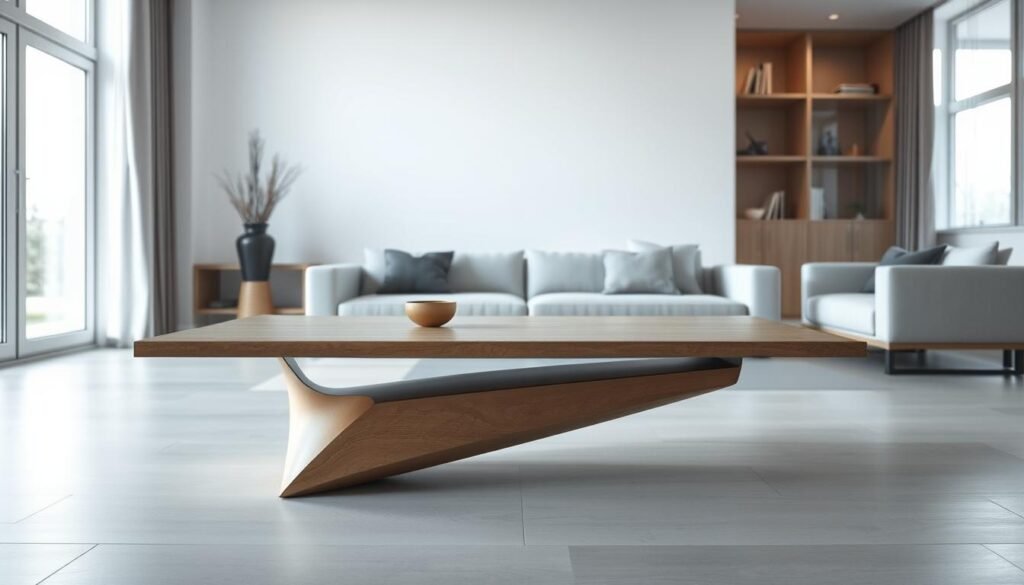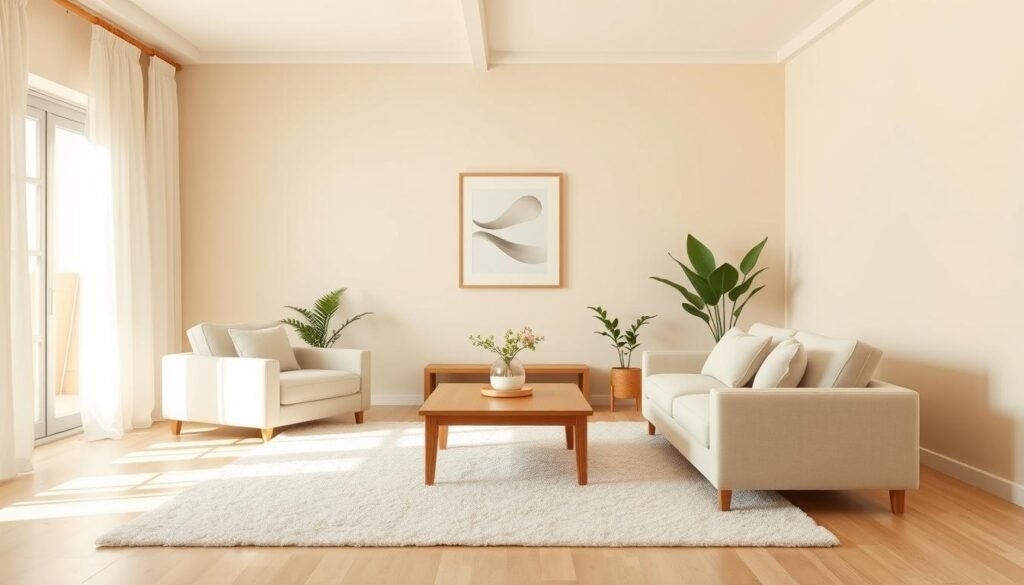This post may contain affiliate links. When you purchase through links on our site, we may earn an affiliate commission.
Last year, I found myself staring at a pile of unused items in my living room. Shelves overflowed with trinkets, countertops hid under appliances, and every corner felt heavy. Then I discovered a kitchen redesign that changed everything. By removing excess and focusing on clean lines, the space became calm, functional, and deeply personal.
This journey taught me how intentional design shapes daily life. Choosing fewer but meaningful pieces lets rooms breathe. Natural light floods open areas, and neutral tones create harmony. Even small changes—like swapping cluttered walls for a single statement artwork—make spaces feel larger.
Studies show uncluttered environments reduce stress by 30%. My own experience mirrors this. With less to clean or organize, I’ve gained time for hobbies and relaxation. Quality furniture lasts longer, too. A well-crafted sofa or handmade ceramic bowl becomes part of your story.
Key Takeaways
- Spaces with fewer items promote mental clarity and reduce daily stress
- Prioritizing quality over quantity creates lasting value in your environment
- Natural materials like wood and linen add warmth to simple designs
- Open layouts and functional storage make maintenance effortless
- Neutral color palettes establish timeless appeal that adapts to trends
Exploring the Philosophy of Minimalist Home Decor
Walking into my friend’s kitchen last summer changed how I view spaces. Every surface felt purposeful—a marble countertop held only a cutting board, and sleek cabinets hid appliances I didn’t even know they owned. That day, I realized simplicity isn’t empty; it’s curated intention.
https://www.youtube.com/watch?v=MxiopY-y5Gg
The “Less Is More” Mindset
Creating minimalist spaces starts with asking, “Does this add value?” I began with one room—my office—removing everything except my desk and favorite chair. Suddenly, ideas flowed easier. Functional furniture like wall-mounted shelves and a compact desk became tools, not distractions.
Clear surfaces became my mantra. Instead of filling walls with generic prints, I chose a single bold art piece. Open shelves now display only books I reread or ceramics from travels. As designer Dieter Rams once said, “Good design is as little design as possible.”
Benefits of a Clutter-Free Space
Fewer furniture pieces mean fewer decisions each morning. My living area uses a modular sofa and nesting tables, which adapt for guests or solo movie nights. Walls stay thoughtfully bare except near the reading nook, where framed photos add warmth without chaos.
A real-life example? My neighbor transformed her dining area by swapping a bulky hutch for floating shelves. Now, her grandmother’s dishes shine as functional decor. Simple tip: arrange furniture to highlight natural pathways. You’ll notice how an entire room feels larger when movement isn’t blocked.
Step-by-Step Guide to Creating a Minimalist Home
A cluttered room can drain energy, but transformation begins with small steps. Focus on balancing function and beauty while keeping surfaces purposeful. Let’s break down the process into manageable stages.

Starting with Essential Furniture and Decluttering
Begin by removing items that don’t serve daily needs. In my living room, I kept a sofa, two chairs, and a wooden coffee table. Everything else? Donated or stored. Ask: “Does this piece solve a problem or spark joy?”
| Room | Essential Items | Avoid |
|---|---|---|
| Living Area | Sofa, coffee table, lighting | Excessive side tables |
| Bedroom | Bed, nightstand, lamp | Decorative pillows (over 3) |
| Kitchen | Daily-use appliances | Single-task gadgets |
Designing Clear Surfaces and Open Spaces
Keep tables and countertops 80% empty. My rule? Only display items used weekly. For example, a coffee tray stays on the table, but remotes go in a drawer. Earth colors like warm beige or soft gray make surfaces feel calm.
Arrange furniture to create natural pathways. Place your coffee table 18 inches from the sofa—close enough for convenience but spacious for movement. Open layouts work best with multifunctional pieces, like ottomans with hidden storage.
Incorporating Sentimental Touches Intentionally
Display meaningful items without overcrowding. I rotate family photos seasonally and use a single shelf for travel souvenirs. As organizing expert Marie Kondo advises: “Keep only what speaks to the heart.”
Mix muted tones with vibrant accents. Try pairing sage walls with a navy throw pillow or a terracotta vase. This adds depth while maintaining serenity. Remember: every decorative choice should feel deliberate, not accidental.
Design Tips and Practical Ideas for a Minimalist Home
When redesigning my studio apartment, I learned that thoughtful choices create balance. Neutral tones and natural textures became my foundation, while curated displays added character. Let’s explore how to blend simplicity with self-expression.

Selecting Neutral Colors and Natural Materials
Start with a base of warm whites, soft grays, or earthy beiges. These shades make rooms feel airy and adaptable. Pair them with materials like oak, linen, or stone for organic warmth. In my kitchen, a white oak breakfast table became the centerpiece, complemented by clay pots holding fresh herbs.
| Color Palette | Material Pairing | Example Use |
|---|---|---|
| Warm Beige | Rattan & Cotton | Living room armchair |
| Soft Gray | Concrete & Wool | Bedside lamp base |
| Cream White | Oak & Linen | Dining table setup |
Using Shelves and Artwork to Reflect Your Personality
Open shelves let you showcase favorite items without overcrowding. I display three things at a time: a handcrafted bowl, a vintage book, and a small plant. Rotate pieces seasonally to keep the look fresh. For artwork, choose one statement piece per wall. A framed textile from Morocco above my sofa sparks conversation without visual noise.
Leave floors mostly clear—a patterned rug can anchor seating areas without clutter. When arranging furniture, allow 24 inches of walking space around each piece. This creates flow and makes cleaning easier. Remember: every item should earn its place through beauty or function.
Conclusion
Six months ago, my bedroom felt like a storage unit—until I applied what I learned. Now, every room serves its purpose with calm functionality. A streamlined kitchen lets me cook joyfully, while smart storage keeps counters clear for morning coffee.
Remember: thoughtful spaces aren’t empty. They highlight what matters. A single photo from your last hike or fresh flowers on the table adds life without clutter. I store seasonal objects in labeled bins, displaying only what I use weekly.
This journey taught me that simplicity thrives through intention. From choosing neutral tones to arranging furniture for flow, each step builds harmony. Your space should reflect your story—not trends or excess.
Start small. Clear one drawer. Swap crowded shelves for three meaningful objects. Notice how breathing room sparks creativity and eases daily tasks. You’ve got this—transform your surroundings into a sanctuary that works for you, not against you.

 using WordPress and
using WordPress and 
No responses yet